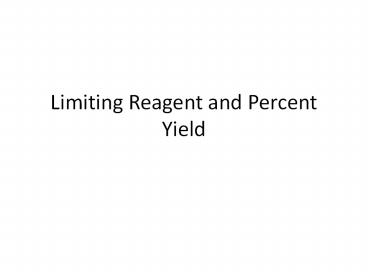Limiting Reagent and Percent Yield - PowerPoint PPT Presentation
Title:
Limiting Reagent and Percent Yield
Description:
Limiting Reagent and Percent Yield Limiting Agent The limiting reagent limits or determines the amount of product that can be formed in a reaction. – PowerPoint PPT presentation
Number of Views:280
Avg rating:3.0/5.0
Title: Limiting Reagent and Percent Yield
1
Limiting Reagent and Percent Yield
2
Limiting Agent
- The limiting reagent limits or determines the
amount of product that can be formed in a
reaction. - The reaction occurs only until the limiting
reagent is used up.
3
Limiting Agent
- The reactant that is not completely used up in a
reaction is called the excess reagent. - The amount of product formed in a reaction can be
determined from the given amount of limiting
reagent.
4
Determining the Limiting Reagent in a Reaction
- What is the limiting reagent when 80g Cu reacts
with 25g S? - 2Cu(s) S(s) ? Cu2S(s)
- Step 1 convert to moles
- 80g Cu x (1 mol Cu/63.5g Cu) 1.26 mol Cu
- 25g S x (1 mol S/32.1g S) 0.779 mol S
5
Determining the Limiting Reagent in a Reaction
- Step 2 Look at the mole ratio from the balanced
equation - There is 2 moles of Cu for 1 mole of S.
- Step 3 Find the amount of moles in the equation.
- 1 mol of S .779 mol S
- 2 moles of Cu 1.26 mol Cu x (1 mol S/2 mol Cu)
0.630 S - Since the amount of sulfur needed is 0.630 moles
and the given amount is 0.779 moles, this
indicates that sulfur is in excess. Thus copper
is the limiting reagent.
6
Determining the Limiting Reagent in a Reaction -
Practice
- 23. If 2.70 mol C2H4 is reacted with 6.30 mol O2,
identify the limiting reagent.
7
Determining the Limiting Reagent in a Reaction -
Practice
- 24. Identify the limiting reagent when 6.00g HCl
reacts with 5.00g Mg. - Mg(s) 2HCl(aq) ? MgCl2(aq) H2(g)
8
Using a Limiting Reagent to Find the Quantity of
a Product
- What is the maximum number of grams of Cu2S that
can be formed from - 2Cu(s) S(s) ? Cu2S(s)
- Step 1 Use moles of limiting reagent to
calculate moles of what you are looking for. - 1.26 mol Cu (from previous problem)
- 1.26 mol Cu x (1 mol Cu2S/2 mol Cu) 0.63 mol
Cu2S
9
Using a Limiting Reagent to Find the Quantity of
a Product
- Step 2 turn moles into grams
- 0.63 mol Cu2S x (159g Cu2S/1 mol Cu2S) 100.17 g
10
Using a Limiting Reagent to Find the Quantity of
a Product
- 25. How many grams of water can be produced by
the reaction of 2.40 mol C2H2 with 7.4 mol O2?
11
Using a Limiting Reagent to Find the Quantity of
a Product
- 26. If 2.70 mol C2H4 is reacted with 6.30 mol O2?
- C2H4(g) 2O2(g) ? 2CO(g) 2H2O(g)
- A. identify the limiting reagent.
- B. Calculate the moles of water produced.
12
Percent Yield
- When an equation is used to calculate the amount
of product that will form during a reaction, a
value representing the theoretical yield is
obtained. - The theoretical yield is the max amount of
product that could be formed from given amounts
of reactants.
13
Percent Yield
- The amount of product that actually forms when
the reaction is carried out in the laboratory is
called the actual yield. - The actual yield is often less than the
theoretical yield.
14
Percent Yield
- The percent yield is the ratio of the actual
yield to the theoretical yield expressed as a
percent. - Percent yield (actual yield/theoretical yield)
x 100
15
Percent Yield
- In calculating the ratio of the actual yield to
the theoretical yield, the percent yield is a
measure of the efficiency of the reaction. - A percent yield should not normally be larger
than 100, but can be lower due to reactions not
going to completion.
16
Calculating the Theoretical Yield of a Reaction
- What is the theoretical yield of CaO if 24.8g
CaCO3 is heated? - CaCO3(s) ? CaO(s) CO2(g)
- Use the 3 Steps
- g CaCO3? mol CaCO3? mol CaO? g CaO
17
Calculating the Theoretical Yield of a Reaction
- 24.8g CaCO3 x (1 mol CaCO3/100.1g CaCO3)
- .248 mol CaCO3
- .248 mol CaCO3 x (1 mol CaO/1 mol CaCO3)
- .248 mol CaO
- .248 mol CaO x (56.1g CaO/1 mol CaO)
- 13.91 g CaO
18
Calculating the Theoretical Yield of a Reaction
- 27. When 84.8 g of iron(III) oxide reacts with an
excess of carbon monoxide, iron is produced. What
is the theoretical yield of this reaction? - Fe2O3(s) 3CO(g) ? 2Fe(s) 3CO2(g)
19
Calculating the Theoretical Yield of a Reaction
- 28. When 5g of copper reacts with excess silver
nitrate, silver metal and copper nitrate are
produced. What is the theoretical yield of silver
in this reaction?
20
Calculating the Percent Yield of a Reaction
- What is the percent yield of the reaction if the
theoretical yeild of CaO is 13.9g and 13.1 g CaO
is produced? - yield (actual yield/theoretical yield) x 100
- (13.1g/13.9g) x 100 94.2
21
Calculating the Percent Yield of a Reaction
- 29. if 50g of silicon dioxide is heated with an
excess of carbon, 27.9g of silicon carbide is
produced. What is the percent ield of this
reaction?
22
Calculating the Percent Yield of a Reaction
- If 15g of nitrogen reacts with 15g of hydrogen,
10.5g of ammonia is produced. What is the percent
yield of this reaction?































